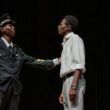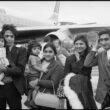In late February and early March of 1959, British Protectorate security officials in Uganda were caught off guard by a series of mass rallies in Kampala. Having just concluded a successful visit from the Queen Mother, they filled their reports with details about the activities of Uganda’s nationalist politicians like ‘Jolly’ Joe Kiwanuka and Milton Obote. With typical condescension, Governor Frederick Crawford reported that the biggest threat to British supremacy was the ‘pan African emotionalism’ of an increasingly assertive African political class. However, for the next year British governance in Uganda faced its greatest challenge from a populist movement led by men and women who were largely unknown to Uganda’s security apparatus. These activists denounced British rule but directed their energy at policing Africans’ interactions with Asian traders in an effort to starve the latter of business and promote their Baganda counterparts.
The 1950s were a period of seismic demographic and infrastructural change in Uganda. Between the 1948 census and the 1959 census, Kampala’s population grew from 62,264 to 107,058. These figures masked even greater growth in peri-urban and up-country trading centres, particularly in Buganda – the powerful kingdom at the geographic and political centre of Uganda. As urban centres grew, so too did Uganda’s Asian population. In 1948, census takers counted 35,279 ‘Indians’ and ‘Goans’, including 18,857 in Buganda. By 1959, those numbers (including a newly introduced category ‘Pakistanis’) were 71,933 including 38,910 in Buganda. Moreover, the 1959 census data reflected an increasingly settled Ugandan Asian population with more than half under the age of 15 and a more balanced male-to-female ratio. As Richa Nagar and Gijsbert Oonk have demonstrated, the practice of earlier generations to build families in India had given way by the 1940s to material and sentimental investments in East Africa as a permanent home.
The demographic changes of the 1950s were not just in raw numbers but also in the forms of mobility and the economic relationships to which both Asian traders and African farmers, traders and consumers had access. Growing availability of bicycles, the expansion of Protectorate road networks as well as so-called ‘pirate taxis’ facilitated movement between rural communities, trading centres and towns. Mobility accompanied commerce, which exacerbated tensions in the racialized economy under British rule. In 1949, the activist Ignatius Musazi led farmers in protesting the dual forces of unaccountable chiefs and Asian cotton-buyers who together constituted the primary interface that many Africans had with the exploitative forces of colonial capitalism. By 1959, the energy of those tensions had shifted from rural farmers to urban traders and consumers.
In late February 1959, Musazi and an assemblage of other Baganda politicians united behind a little-known 29-year-old activist named Augustine Kamya, a Catholic tradesman with seemingly close ties to the Protestant ministers surrounding the Kabaka of Buganda. Along with colleagues Musa Bulwadda, Yosia Sekabanja, Christine Nkata and Alamanzane Kasirye (also known as Hajji Busungu, meaning ‘Fury’), Kamya combined four demands into one platform of popular activism: end British colonialism, elevate kingships, empower African traders, and Africanize trading centres and small towns. Catching British officials and non-Baganda politicians such as Milton Obote by surprise, this group called itself the ‘Uganda National Movement’ (UNM) and assembled the largest political gatherings in Uganda’s history to that point. According to some estimates, around 15,000 people assembled by the iconic ‘tree of freedom’ near Kampala’s taxi park in order to hear a parade of speakers denounce British rule and the unequal economy that it facilitated.
The projection of economic inequality along what came to be understood as racial lines had a complicated history in East Africa, but it was inseparable from colonial governance. Traders from the Indian Ocean world preceded British officials but quickly became enmeshed in the expansion of colonial administration. In the early years of the Protectorate, British officials quickly abandoned the idea of Asian agricultural settlements and worked to exploit the success of many Asian traders while cultivating a paternalistic public image toward African interests. Legislation restricted ‘non-natives’ to leasing land and trading in towns or trading centres. Following World War II, the Protectorate attempted to placate aspiring African traders with loans and designated trading areas with less costly building restrictions. However, the system was deliberately full of loopholes, especially in Buganda where discretion was given to the Kabaka’s government to authorize up-country trading licenses. As towns and trading centres increased, so too did the population and visibility of Asian retail traders.
Augustine Kamya’s rallies struck a chord with many Baganda in the context of looming political crisis. The Protectorate had recently established a Constitutional Committee to recommend a small expansion to Africans’ limited voting rights, which simultaneously revealed cracks in British dominance and threatened the privileged status of Buganda’s monarchy under British indirect rule. Many Baganda felt both politically and economically embattled. As early as 1952, licensed African traders outnumbered their Asian counterparts 11,634 to 4,809 but handled only a third the amount of business. Such inequalities were particularly acute in Buganda, a centre of cotton and coffee production that was home to 80 percent of all licensed traders in the Protectorate. Urbanization and popular activism against the Kabaka’s 1953 forced exile had also empowered women and non-Baganda in urban markets and in political mobilization. As one contemporary scholar noted, towns and trading centres in the 1950s expanded economic relationships between Asian shopkeepers and a diversity of African customers that were ‘intimate’ but often ‘lacking in mutual trust’.
Upwardly mobile men and women in Buganda’s trading centres thus became fertile ground for economic populism that elevated the interests of Baganda capitalists to the centre of anti-colonial demands. Kamya declared, ‘All trade is put into the hands of Africans. From this hour no African should enter a non-African shop.’ The goal, he was quoted as saying in the Uganda Argus, was to ‘remove Asians from the villages and to bring trade into the hands of Africans.’
From today’s vantage point, Kamya’s words superficially correspond with Idi Amin’s expulsion decrees more than a decade later, but such a comparison ignores profound divergences between Kamya and Amin in both the contents and the forms of action that they pursued. Unlike Amin’s dictatorship, Kamya’s UNM was a genuinely populist movement, dependent on the energies of ordinary people to uphold a vision of urban belonging and anti-colonial emancipation that excluded Asians and empowered an elite group of Baganda capitalists. Kamya’s movement enlisted ordinary people to enforce a boycott of foreign consumer goods and Asian traders. He instructed a rally, ‘Should [a person who violated the boycott] have a bicycle and get a puncture he should not be lent a pump.’ Neither should food vendors sell ‘to anyone rebelling against the order of the nation.’
British authorities quickly banned the UNM and imprisoned Augustine Kamya, but the boycott of Asian shops continued for more than a year, backed by a campaign of intimidation and violence. African traders who stocked boycotted goods from Asian wholesalers received anonymous threatening letters, such as one that read, ‘If I inspect the shops again and find Brook Bond Tea, I will sentence the offender to death.’ These were not empty threats. Hundreds of cases of arson and crop-slashing were reported across Buganda, most of which were preceded by anonymous written threats instructing the recipient to break their social and economic ties with Asians. Hundreds of ordinary people were arrested for threats or violence in support of the boycott. Newspapers and police reports noted a common tactic where someone stood outside the entrance to an Asian shop with a pencil and notepad recording who had entered. Some boycott enforcers used cameras to create the impression that anyone approaching an Asian shop could be identified and later subjected to violence or destruction of their property.
Asian traders and the goods they sold were not only a materialization of colonial capitalism’s injustices – they were also part of a consumer culture to which many Africans aspired and in which they enthusiastically participated. The UNM’s boycott garnered popular participation, but it required intimidation and violence because African consumers were deeply enmeshed in partially shared economic and social worlds with Asians. The pro-boycott Luganda language newspaper Uganda Empya continued to run advertisements for soda, beer and other boycotted products. The paper also described ordinary people’s suffering without access to consumer goods.
As boycott enforcement grew more violent, many Asian traders and their families were forced to leave up-country trading centres for larger towns and cities. In the first six months, the boycott cost the Protectorate £600,000 in tax revenue, reflecting severe losses for many traders. By 1960, the political momentum that had spurred the boycott had faded, as the Constitutional Committee released its report, Buganda pursued an abortive declaration of independence, and Kabaka Mutesa worried about the effects of social unrest. But a small group of boycott enforcers began directly targeting Asian shops with home-made bombs and improvised firearms. After one such bombing in Ngogwe, journalists reported that despite a large crowd nearby, ‘the people did not care to come to help’.
For families forced to leave up-country towns, the events of 1959-1960 were devastating. The late Taj Kassam moved to Gomba in 1954 at age 16. He later recalled, ‘I liked the culture of Ugandans, [especially] their extended family concept. So, within no time, I become part of it.’ As he built his business supplying several dozen shops managed by Africans in the surrounding area, he learned Luganda fluently, volunteered in a nearby school, provided a free ambulance service and developed warm relationships in the community. But in 1959 his friends, customers and business partners withdrew, and he was eventually forced to move. Although his business flourished in Kampala, he was distraught by the loss of community he had experienced as a young man in Gomba.
As Uganda, Ugandan Asians and the world mark fifty years since Idi Amin’s expulsion decrees in 1972, it is important to remember other moments of dislocation and rupture such as the 1959 boycott. The boycott ultimately petered out, and one of its harshest critics Milton Obote led Uganda to independence in 1962. Although both the 1959 boycott and the 1972 expulsion were experienced as anti-Asian persecution, they had divergent political genealogies. One of the first victims of Idi Amin’s military regime was Augustine Kamya, who spent the early months of 1971 after Amin’s coup advocating for the interests of established African traders, especially in Buganda. He was soon murdered by Amin’s soldiers, who became the primary short-term beneficiaries of the expulsion.
Expulsions are violent manipulations of memory and politics. Propagators of expulsions seek to disentangle the threads of history by creating a foundational rupture. For expelled communities, these divisions can also take on monumental significance in the aftermath of trauma, dividing an idyllic past from an uncertain present. But narratives that elevate a single expulsion event can miss longer histories, with multiple experiences of entanglement and dislocation. 1959-1960 offers one such alternative lens through which to enter the history of Asians in Ugandan society. Revisiting these histories can direct attention away from the mythologised figure of Idi Amin, and toward the contexts of British colonialism and capitalism that Africans and Asians navigated in tense times.





